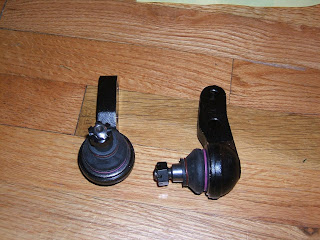Over the past week, I've been distracted with an unplanned "might as well." In this case, it involved the inner fenders.

You see, the inside fenders were coated with lots of dirt, over which a layer of undercoating was sprayed. On top of that, some of the body paint oversprayed into the inner fenders, making things look a bit strange. However, there was no sign or rust or any other nasty/terminal things. To my untrained eye, everything looked functionally OK (if not necessarily pretty.)
Given this, I originally planned leaving the inner fenders alone. But the thought of trying to paint the inner fenders started creeping up on me. And the guys at Group 2 gave me enought pointers that I felt I'd be able to try this without hurting myself too badly.
First, one must clean all the gunk and dirt. Since the car was parked inside my garage, I used a few drip pans, a big bucket of water, a few spray bottles to limit the amount of water getting sprayed all over the garage, as well as a big cleaning brush and tons of paper towels. To clean the inner fenders, I used a degreaser called "Krud Kutter." Since "krud" would be a good description of the stuff facing me, I figured this would be useful. I diluted the degreaser down 5:1, and sprayed it all over the inner fender, scrubbing with the brush and paper towels.
Cleaning the inner fender area exposed the car's original color - which I can't still figure out. The original color is either Rosso Amaranto () or Prugna (Plum Purple). The current car color is Alfa Red; if I ever restore the car, I'll probably go back to the original color - I think it would look great.
(Note: here is an Alfa Bulletin Board post of a much nicer GTV in Rosso Amaranto. )
Cleaning was tedious, messy, wet, and uncomfortable. It took me three nights (1.5 hours per night) to get the fenders clean enough for spraying.
 Once clean, I masked a few sections, and coated the inner fenders with Wurth High-Build Underseal (this thing sticks to everything!) Again, the lack of room made spraying very uncomfortable. But with a bit of patience, I was able to spray things OK.
Once clean, I masked a few sections, and coated the inner fenders with Wurth High-Build Underseal (this thing sticks to everything!) Again, the lack of room made spraying very uncomfortable. But with a bit of patience, I was able to spray things OK.After about 90 minutes, the undercoating had dried enough to remove the masking. Also after 90 minutes, the buzz from all the chemicals started to wear off, too!
So now, the inner fenders look much better - not councours quality, but good enough for daily driver car. And I am hoping the undercoating will help keep rust away for a bit longer.

And again, the guidance from the guys at Group 2 was very dead on - this is something that was doable, and seems to have worked well (so far.)
I left parts of the inner fender without painting, in order to leave the original color exposed. These areas did not look rusty at all - the paint was holding up very well. I figured this way, if/when I repaint this car, I'll be able to match the original paint.
Given the limited space, I am happy with the results. I give myself a C grade - not necessarily great, but passing nonetheless.
Next up: I start putting things back together. Really... I mean it this time... Seriously...












